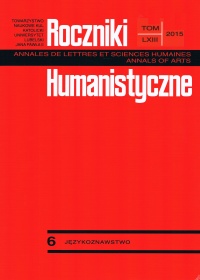Two Typologies of AP Predicates in Polish – a Comparison
Abstract
The paper examines two typologies of predicates found in the literature, put forward for languages other than Polish, mostly English, Spanish, Russian, and French. The first typology goes back to Milsark (1974) and Carlson (1977), who argue for dividing predicates into individual level and stage level. The former roughly correspond to stable properties, the latter to the transient ones. The distinction has its manifestations in syntax and semantics. The paper shows that the dichotomy is also present in the case of Polish AP predicates. The other typology, that of Roy (2013), posits the distinction between characterizing and situation-descriptive adjectival predicates. The paper demonstrates that this distinction is valid for Polish, as well. The two typologies have been compared with each other. It has been argued that the IL/SL dichotomy allows us to classify a given adjectival predicate as a member of one class or the other, whereas in Roy’s (2013) typology a particular adjective can be either characterizing or situation-descriptive, depending on the context. EAs constitute a class of adjectival predicates that escapes a uniform classification in both typologies under scrutiny.
References
Arche M. J.: Individuals in time: tense, aspect and the individual/stage distinction, Amsterdam 2006.
Bondaruk A.: Copular clauses in English and Polish. Structure, derivation and interpretation, Lublin 2013.
Bondaruk A.: Characterizing and defining predicational clauses in Polish, in: Complex Visible out there. Proceedings of the Olomouc Linguistics Colloquium 2014: Language Use and Linguistic Structure, eds. L. Veselovská and M. Janebová, Olomouc 2014, pp. 1-16.
Carlson G.: Reference to kinds in English, Ph. D. dissertation, University of Massachusetts, Amherst 1977.
Chierchia G.: Individual-level predicates as inherent generics, in: The Generic book, eds. G.N. Carlson and F.J. Pelletier, Chicago and London 1995, pp. 176-223.
Citko B.: Small clauses reconsidered: Not so small and not all alike, “Lingua” 118(2008), pp. 261-295.
Diesing M.: Indefinites, Cambridge (MA): the MIT Press 1992.
Escandell V. and Leonetti M.: Coercion and the stage/individual distinction, in: Semantics and pragmatics of Spanish, ed. J. Gutiérrez-Rexach, Amsterdam: Elsevier 2002, pp. 159-179.
Fábregas A., Leferman B. and Marín R.: Evaluative adjectives and Davidsonian states, in: Proceedings of Sinn und Bedeutung 17, eds. E. Chemla, V. Homer and G. Winterstein, Paris 2012, pp. 237-253.
Gallego Á. and Uriagereka J.: The lexical syntax of ser and estar, ms., Universitat Autónoma de Barcelona and University of Maryland 2011.
Hentschel G.: Morphosyntaktische Markierung sekundärer Prädikate, in: The Slavic langauges. An international handbook of their structure, their history, and their investigation, eds. S. Kempgen, P. Kosta, T. Berger, and K. Gutschmidt, Berlin and New York 2009, pp. 369-391.
Hinterhölzl R.: Semantic constraints on case assignment in secondary adjectival predicates in Russian, “ZAS Papers in Linguistics” 22(2001), pp. 99-112.
Jäger G.: Stage levels, states, and the semantics of the copula, “ZAS Papers in Linguistics” 14(1999), pp. 65-94.
Kratzer A.: Stage-level and individual-level predicates as inherent generics, in: The generic book, eds. G. N. Carlson and F.J. Pelletier, Chicago–London 1995, pp. 125-175.
Ladusaw W.A.: Thetic and categorical, stage and individual, weak and strong, in: Proceedings of SALT IV, eds. M. Harvey and L. Santelmann, Cornell (Ithaca) 1994, pp. 220-229.
Leonetti M.: Ser y estar: estado de la cuenstión, “Barataria” 1(1994), pp. 182-205.
Maienborn C.: Situationsbezug und die Stadien/Individuen-Distinktion bei Kopula-Prädikativ-Konstruktionen, “ZAS Papers in Linguistics” 14(1999), pp. 41-64.
McNally L.: Adjunct predicates and the individual/stage distinction, in: Proceedings of WCCFL 12, eds. D. Farkas, P. Spaelti and E. Duncan, Stanford (CA) 1994, pp. 561-576.
Manninen S.: A minimalist analysis of stage level and individual level, “Working Paper in Linguistics” 1(2001), Lund, The Department of English in Lund.
Marín R.: Entre ser y estar, Madrid 2004.
Marín R.: Spanish adjectives within bounds, in: Adjectives: formal analyses in syntax and semantics, eds. P. Cabredo-Hoffher and O. Matushansky, Amsterdam 2010, pp. 307-332.
Milsark, G.: Existential sentences in English, Ph. D. dissertation, Cambridge (MA) 1974.
Pustejovsky J.: The generative Lexicon, Cambridge (MA) 1995.
Ramchand G.: Two subject positions in Scottish Gaelic: The syntax-semantics interface, “Natural Language Semantics” 4(1996), pp. 165-191.
Rapoport T.: Adjunct predicate licensing and D-structure, in: Syntax and semantics 25, Perspectives on phrase structure; heads and licensing, ed. S. D. Rothstein, San Diego 1991, pp. 159-187.
Rapoport T.: Stage and adjunct predicates, in: Knowledge and language. Vol. II: Lexical and conceptual structure, Dordrecht–Boston–London 1993, pp. 157-182.
Renz M. and Hentschel G.: On adjectives and adverbs expressing ‘nakedness’ and ‘barefootness’ in Polish and Russian: a study on morphosyntactic variation, “Russian Linguist” 35(2011), pp. 63-87.
Richardson K.: What secondary predicates in Russian tell us about the link between tense, aspect and case, “ZAS Papers in Linguistics” 26(2001), pp. 152-177.
Roy, I.: Nonverbal predication. Copular sentences at the syntax-semantics interface, Oxford 2013.
Szajbel-Keck M.: Prepositional secondary predication in Polish: adjectives in complex constructions, paper presented at FASL 22, 2014.
Wade T.: A comprehensive Russian grammar, Oxford 1992.
Copyright (c) 2015 Roczniki Humanistyczne

This work is licensed under a Creative Commons Attribution-NonCommercial-NoDerivatives 4.0 International License.





